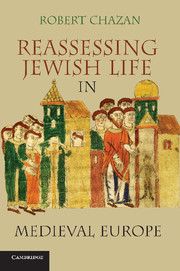Book contents
- Frontmatter
- Contents
- Acknowledgments
- Prologue: Group Narratives: Their Tenacity and Their Accuracy
- Introduction: The Emergence of Medieval European Jewry
- Part I Historical Schemes
- 1 The Jewish Middle Age: The Jewish View
- 2 The Jewish Middle Age: The Christian View
- 3 The European Middle Ages
- 4 The European Jewish Middle Ages
- Part II Historical Themes
- Bibliography
- Index
4 - The European Jewish Middle Ages
Published online by Cambridge University Press: 05 June 2012
- Frontmatter
- Contents
- Acknowledgments
- Prologue: Group Narratives: Their Tenacity and Their Accuracy
- Introduction: The Emergence of Medieval European Jewry
- Part I Historical Schemes
- 1 The Jewish Middle Age: The Jewish View
- 2 The Jewish Middle Age: The Christian View
- 3 The European Middle Ages
- 4 The European Jewish Middle Ages
- Part II Historical Themes
- Bibliography
- Index
Summary
The new division of history that surfaced toward the close of the European Middle Ages reconfigured the traditional Christ-centered triad of glorious past, decadent present, and splendid future. The new glorious past centered on Greece and Rome, rather than Jesus; the decadent middle period involved the triumph of Christianity; the splendid future would revive the values of Greece and Rome and repudiate the values of Christianity. Enlightenment thinkers reinforced and sharpened this new tripartite division of history.
The changes in European society associated with modernity included altered status for European Jewry. Slowly and subtly, some Jews began to integrate themselves into majority society. The process of integration accelerated explosively with the formal restructuring of Western polities as a result of the American and French revolutions. Increasingly large numbers of Jews found themselves absorbed into drastically reconfigured Western societies. Integration proceeded at many different levels, including the demographic, the economic, the political, and – not least – the cultural. An inevitable result of this integration was assimilation of the new ideas, ideals, and values of Enlightenment and post-Enlightenment thinking. The challenge – keenly felt within nineteenth- and twentieth-century Western Jewry – was somehow to engage the new patterns of thought while remaining grounded in the core legacy of the Jewish past.
- Type
- Chapter
- Information
- Reassessing Jewish Life in Medieval Europe , pp. 64 - 82Publisher: Cambridge University PressPrint publication year: 2010



